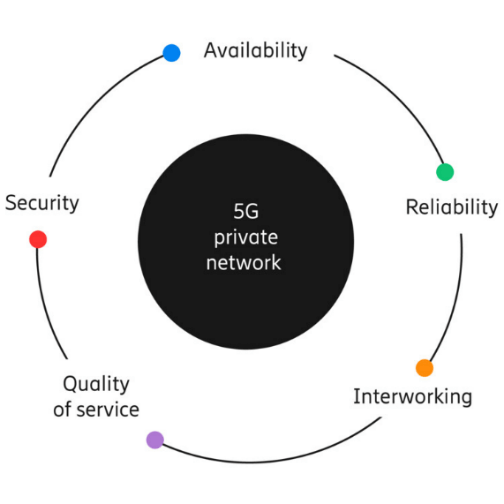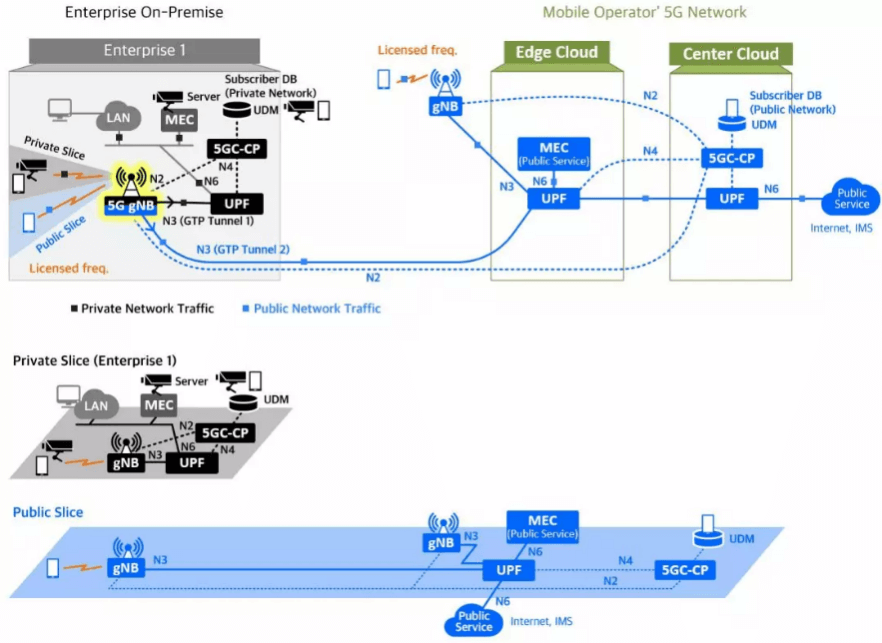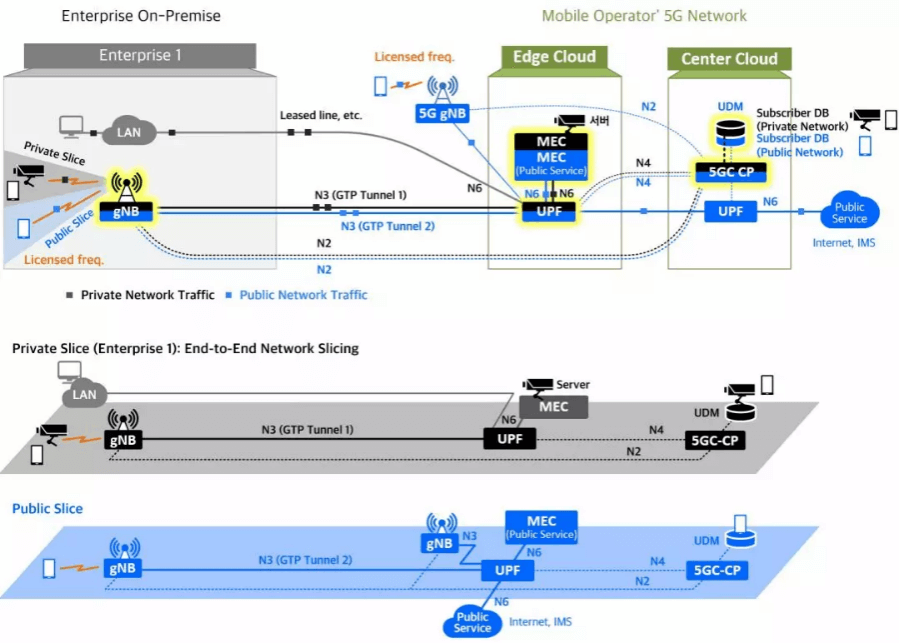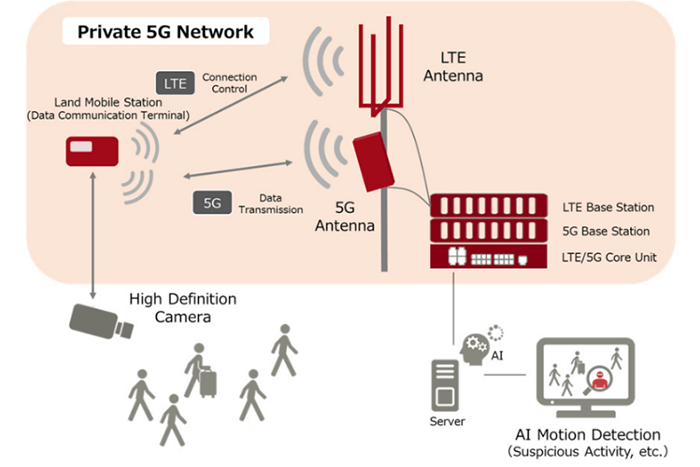A private 5G network is a local area network (LAN) that will use 5G technology to create a private network with unified connectivity, optimized services, and secure communication methods in a specific area.
In fact, the concept of a private 5G network has been around since the 2G/3G/4G era, and it is not new to us. A private network is a professional network that provides network signal coverage in a specific area to provide communication services to specific users.
In short, a private network is a dedicated network that provides network communication services for specific users. The difference between a public network and a private network is mainly that a public network serves the general public, while a private network serves specific objects.
Why do we need to build private 5G networks?
5G networks have three main features: high bandwidth, low latency, and multiple accesses, but many times, enterprises do not need these service features at the same time.
In addition, some enterprises want access to all control over the 5G network, high reliability, security, privacy, etc. The public network cannot fully meet these specific needs.
The private 5G networks provide the freedom for enterprises to customize their networks, offering different configurations based on the location of use and type of work, with clear advantages in terms of privacy and security.

What is the private 5G network requirements?
High availability: means that the network service is always available to users and can ensure maximum availability.
Reliability: refers to the ability to transmit a certain number of services with high reliability for a predetermined duration, requiring sufficient network coverage and capacity, as well as robust service switching capabilities.
Interoperability: Interoperability with the public network is an important function, for example, critical services such as medical ambulances require service continuity when migrating from one network to another (e.g., from a private network to the public network), which requires a degree of integration between networks.
Quality of Service: Quality QoS includes throughput, latency, jitter, packet loss, etc., which can be better controlled by running private networks on the dedicated spectrum. In addition, system performance and resource usage for different services can be tailored to the specific needs in a private network deployment.
Security: Private networks are expected to provide comprehensive end-to-end security to ensure that information, infrastructure, and people are protected from threats. Private networks can leverage network isolation, data protection, and device/user authentication to protect critical assets, and enterprises can also control the retention of data sovereignty to ensure sensitive information remains local.
The relationship between WIFI 6, LTE Private Networks, and Private 5G Networks
Wi-Fi is faster, easier, and cheaper to deploy than dedicated cellular networks and dedicated Wi-Fi networks are already in use in factories, often for some non-critical applications.
Until they have a full 5G industrial network, some enterprises may use a dedicated LTE network as a transition.
LTE has greater coverage and mobility than fixed Ethernet or Wi-Fi and is often the technology of choice for enabling connectivity in industrial environments.
For example, the world’s largest automated terminal Yangshan Port is an industrial wireless network built on 5.8GHz LTE, “The area will no longer be manned and fully automated, not only the shore bridge not need a human driver and can be operated in the background, even the collector truck is no longer needed, directly by the automatic operation of the AGV trolley loading and transporting goods.”.
Ocado UK has also deployed a dedicated LTE network to control 1,000 fast-moving robots in the logistics center to process orders online.
Nokia used a dedicated LTE network (4.9G) to enable base station factories to automate their operations.
Seven deployment options for private 5G networks
There are currently seven major deployment options for private 5G networks as follows.
1. Enterprise-built private 5G network (local 5G band, fully private, no sharing)

The first deployment option is to deploy a full set of 5G networks (gNB, UPF, 5GC CP, UDM, MEC) based on the private network bands. The spectrum used here is a private 5G spectrum, not the operator’s licensed spectrum. Enterprises build their own private 5G networks with high privacy and security, ultra-low latency, and independent controllability.
However, the deployment cost of self-built private networks is high, and ordinary enterprises, especially small enterprises, cannot afford to purchase and deploy a full set of 5G networks, and some professional operation and maintenance personnel are needed to maintain the networks at a later stage.
2. Operators help enterprises build a dedicated 5G network (based on the operator's 5G band, completely private, not shared)

This dedicated 5G network architecture is similar to the first option deployment, the only difference is that the 5G band licensed by the operator is used to build and run the private 5G network.
3. RAN sharing between public and private networks

Only 5G base stations (gNBs) are shared between the private and public networks (RAN sharing), while UPF, 5GC CP, UDM, and MEC are deployed in the enterprise and physically isolated from the public network.
Data traffic belonging to the private network is delivered to the private UPF in the enterprise, and data traffic belonging to the public network is delivered to the UPF in the operator’s edge cloud.
In other words, private network traffic controlled by internal devices is kept only in the enterprise, while public network service traffic like voice and Internet is delivered to the carrier’s network.
4. RAN and control plane sharing between public and private networks

5G base stations (gNBs) and 5GC CPs and UDMs (RAN and control plane sharing) are shared between the private and public networks. Dedicated UPFs and MECs are built into the enterprise, and the gNBs and UPFs of the enterprise private network are connected to and managed by the operator’s network through N2 and N4 interfaces.
Compared with the previous deployment schemes, the device information of the enterprise private network is stored in the operator’s server rather than inside the enterprise, so it is slightly weaker in terms of privacy.
5. RAN and core sharing between public and private networks (end-to-end network slicing)

Private network shares UDM, 5GC CP, UPF, MEC, and 5G base stations with the public network, which means end-to-end network slicing. The security of user information and data traffic depends on the network slicing capability, but this architecture has the lowest cost compared with the previous options.
6.N3 LBO (Local Breakout): the example of SK Telecom in Korea

The enterprise introduces the MEC data plane and MEC applications, and the operator’s Mobile Edge Platform (MEP) sends traffic rules to the MEC DP through the Mp2 interface.
The MEC DP looks at the destination IP address (GTP Decap) of all packets from the GTP tunnel of the gNB and routes the user IP packets to the internal private network.
Unlike options 3 and 4, the cost of building a dedicated 5G network can be greatly reduced by adding a low-cost MEC DP (actually an SDN/P4 switch) without the need to acquire expensive UPF equipment.
7.F1 LBO (Local Breakout): KT case in Korea

The difference is that only the RU/DU in the enterprise is deployed and the CU is placed in the edge cloud of the mobile network, and the private network traffic is disconnected locally from the F1 interface instead of from the N3 interface.
In the end, each of the above 5G private network architectures has its own advantages and disadvantages, and no one architecture can fit all cases. Enterprises should choose the architecture that best suits their requirements and implementation/operation budgets.
What are the challenges of private 5G networks?
1. Spectrum issues of private 5G networks
Building a private 5G network is not an easy task, and with network slicing still in the development stage, the key issue facing several other private 5G network deployments is still access to spectrum.
Private 5G network spectrum resources are limited and not available on demand. In most countries, spectrum is regarded as a natural resource and its use is controlled by national authorities, which allocate resources according to the country’s needs.
In most countries, spectrum is considered a natural resource, and its use is controlled by the national authority, which allocates the resources according to the national demand. When the dedicated spectrum is difficult to obtain, shared spectrum and unlicensed spectrum are also good ways to establish private networks, and more and more operators are investing in unlicensed and shared spectrum resources.
Shared spectrum is a “lightly licensed” use of spectrum, where some national regulators have introduced shared-use spectrum access regimes that allow industry users to deploy their proprietary networks using shared spectrum.
The unauthorized spectrum is a public resource to which enterprises have fair access and therefore requires more sophisticated spectrum planning techniques to reduce interference between each other.
2. National policies of private 5G networks
For large-scale deployment of private networks, in addition to the continuous development of spectrum technology, national support is also needed. Some countries are currently thinking about opening up more spectrum resources and providing policy guarantees so that private 5G networks can develop rapidly.
The industry has always had high expectations for private 5G networks, and despite the challenges that accompany the development process, the number of private network deployments has begun to increase as the technology continues to improve.
ABI Research recently released a report showing that global private 5G network spending will surpass that of public 5G networks by 2036, so how will the market landscape change by then?
A report predicts that global private 5G network spending will surpass 5G public network by 2036, so how will the market landscape change?
Besides the What is a Private 5G Network article, you may also be interested in the below articles.
What Is The Core 5G NR Technology?




